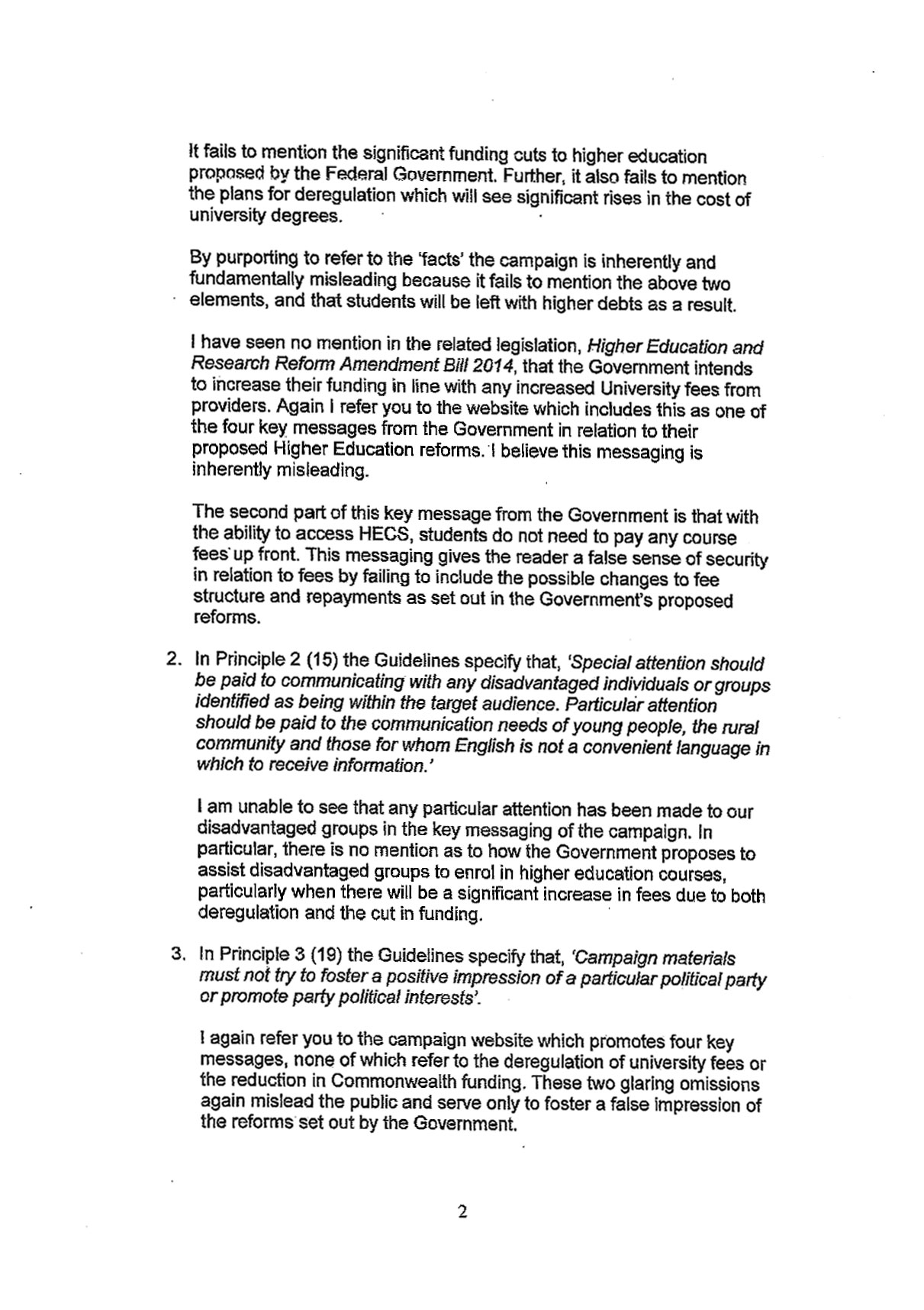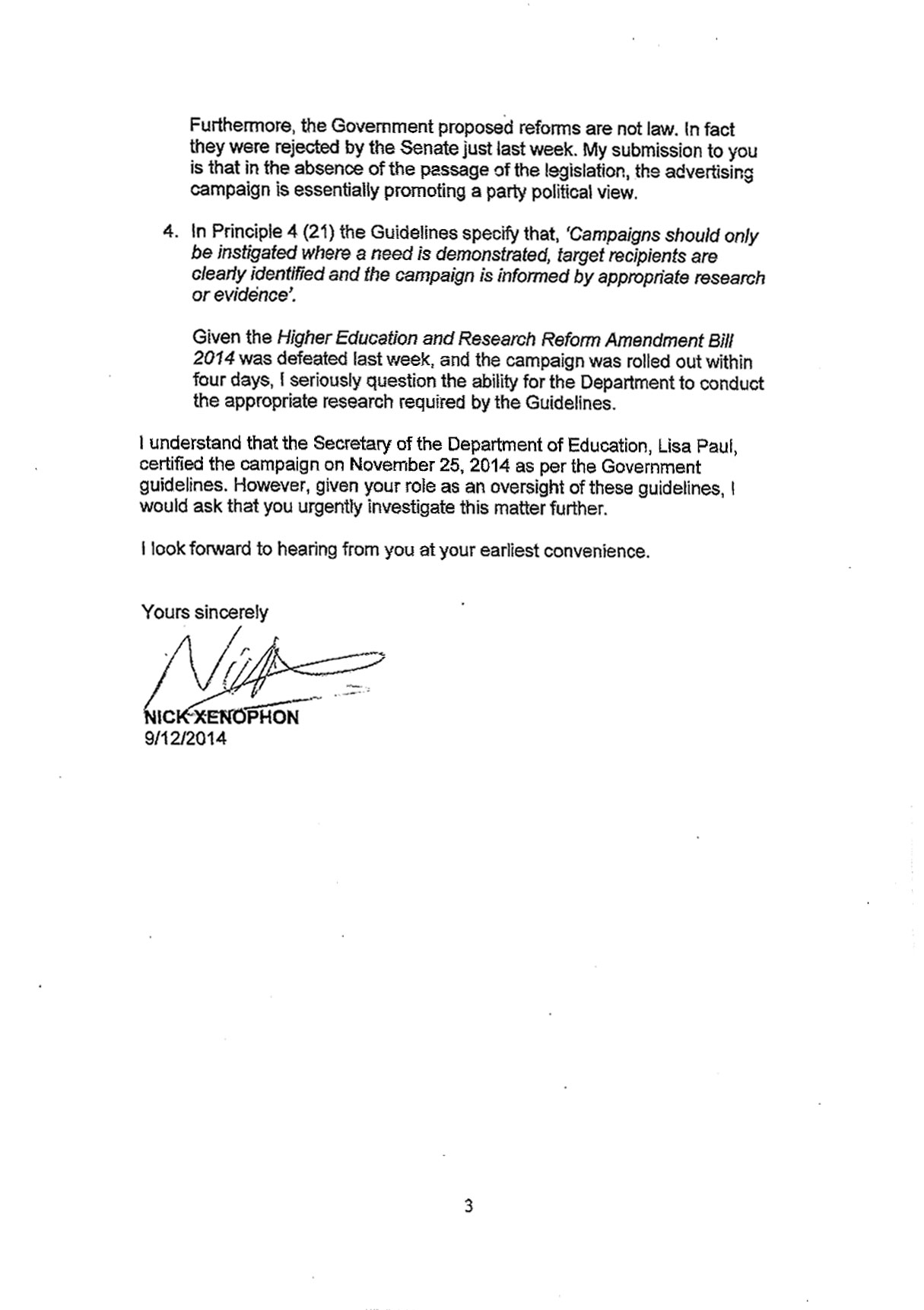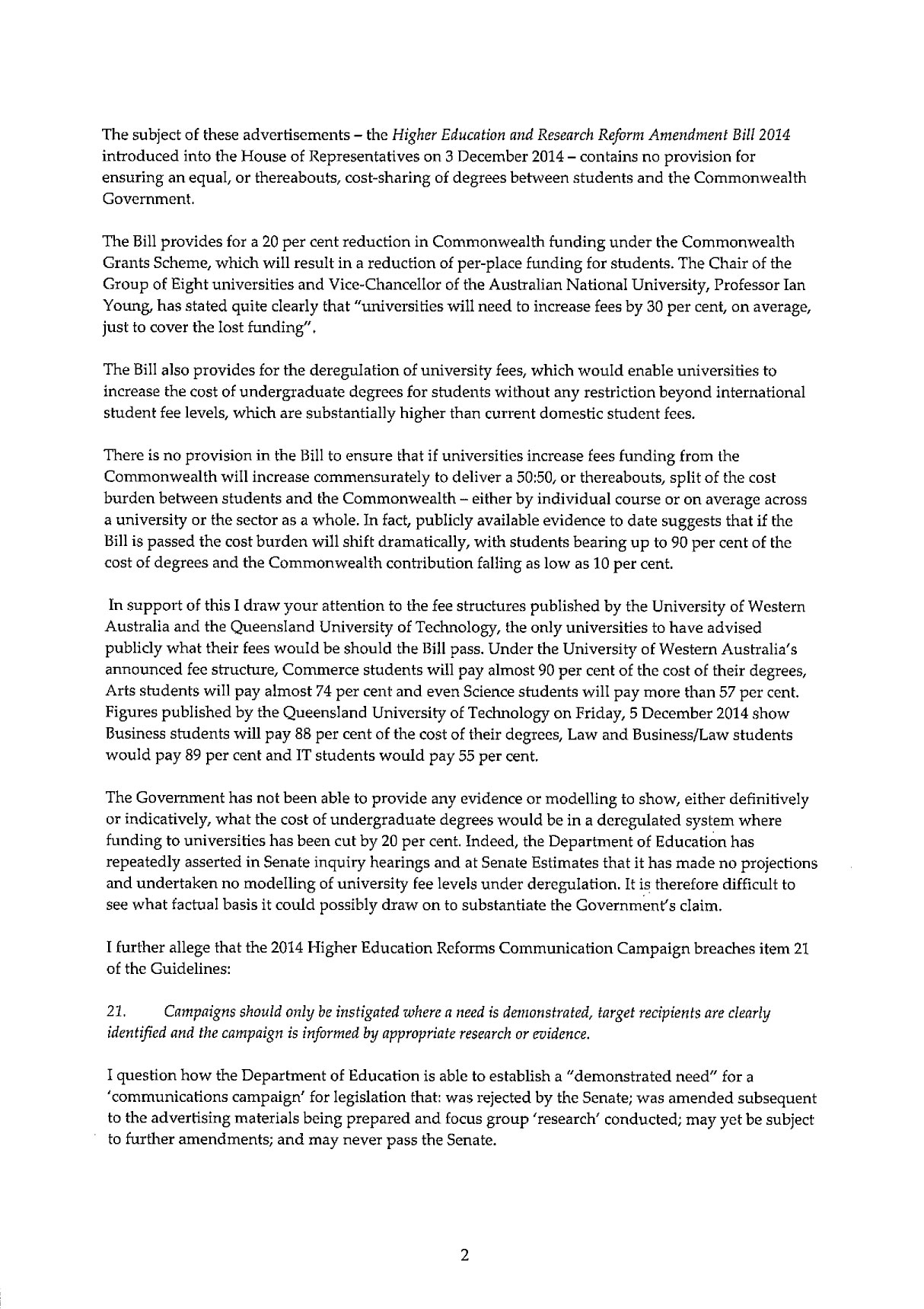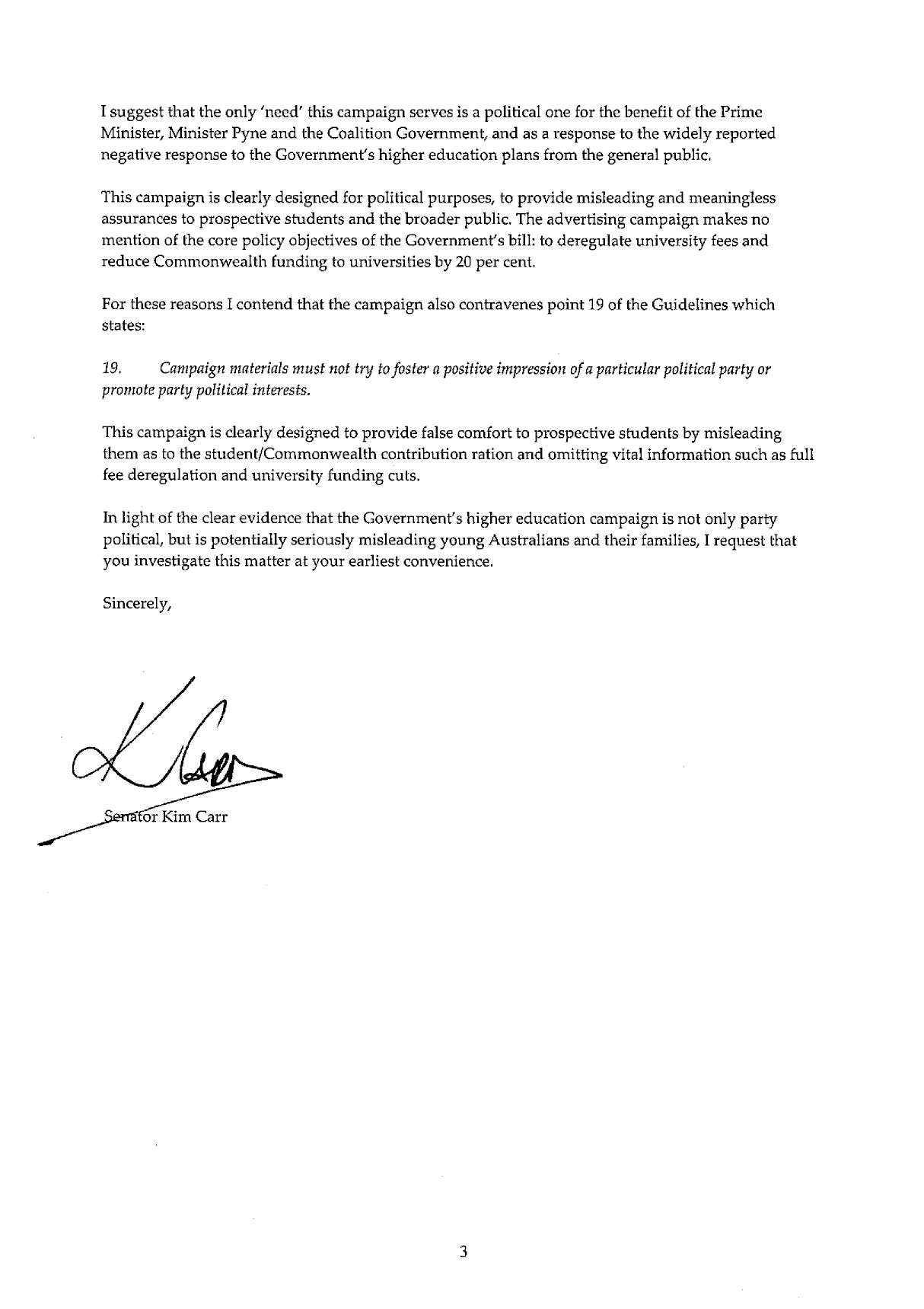Browse our range of reports and publications including performance and financial statement audit reports, assurance review reports, information reports and annual reports.
Australian Government advertising relating to higher education

Please direct enquiries relating to requests for audit through our contact page.
The Auditor-General responded on 20 January 2015 to correspondence from Senator Nick Xenophon of 9 December 2014 and Senator the Hon Kim Carr of 15 January 2015, on the advertising campaign on higher education issues.
Auditor-General's response to Senator the Hon Kim Carr
20 January 2015
Senator the Hon Kim Carr
Labor Senator for Victoria
Parliament House
CANBERRA ACT 2601
Dear Senator Carr
Australian Government advertising relating to higher education
1. I am writing in response to your letter of 15 January 2015 about the Australian Government’s 2014 Higher Education communication campaign (the campaign), administered by the Department of Education and Training (the department). I have also received correspondence on this campaign from Senator Xenophon.
2. The Australian National Audit Office (ANAO) has sought information from the department on the status of the campaign. However, we have not undertaken an audit on this issue, given other planned audit commitments. The inclusion of this campaign will be considered in the context of a future performance audit on government advertising, currently expected to commence by mid-year.
Context
3. The department advised the ANAO that between July and September 2014, it participated in five tertiary skills/career exhibitions and 41 open day events at 36 higher education institutions across Australia. At these events, we were informed that departmental staff spoke with some 8 000 students and their families about Australian Government financial support available to assist with higher education fees, and encountered a range of misconceptions and lack of understanding about general eligibility for Commonwealth support and the Government’s proposed changes announced in the Budget—in particular, there was a misconception that the proposed changes would mean that the HECS-HELP loan scheme would be abolished.
4. The department further advised that the feedback it received was confirmed through qualitative and quantitative developmental research undertaken by ORIMA Research on its behalf. From a policy viewpoint, there arose a concern that widespread lack of knowledge about the university funding system and HECS, combined with misunderstanding of the Government’s proposed changes, might lead to a decline in participation.
Scope and timing
5. The department advised the ANAO that the campaign aims to increase awareness and understanding of the higher education system and available government support. It is intended to create a simple and direct source of information about government support for higher education and to dispel a range of misconceptions held by prospective students and their families.
6. The department expects that the campaign will be delivered in two phases. The first part of Phase 1 ran from 7 to 20 December 2014, with a small number of press and other advertisements appearing until 31 December 2014. The department advised that Phase 1 aims to: counter myths and misconceptions about the current higher education system; raise awareness of government support for higher education and the mechanisms that will remain in place into the future (such as HECS); encourage audiences to seek further information about current Government resources, assistance and financial support for higher education; and set the scene for proposed policy changes. The timing and focus of Phase 2 is expected to be determined in early 2015 on the basis of the outcomes of benchmarking, tracking and evaluation results from Phase 1.
7. The department further advised that the media buy has included placements for television, radio, newspaper, digital and bus shelters, and some below -the-line services such as social media monitoring. Approximately $73 000 was allocated for Indigenous media channels (television, press, radio and digital) and some $72 000 was allocated for culturally and linguistically diverse (CALD) media channels (including radio, press and online). Press and radio advertisements were translated into the following languages: Arabic, Afghan, Burmese, Chinese (Cantonese and Mandarin), Korean, Persian, Somali, Sudanese and Vietnamese. These languages were chosen as they represent emerging communities as well as some established communities that also have high numbers of youth.
Budget
8. The department advised the ANAO that the Government has agreed to an overall budget of $14.6 million for the campaign. Key budget items are:
- media buy - $9.5 million;
- creative development - $2.3 million;
- website - $1.3 million;
- research - $0.8 million;
- contact centre support - $0.5 million; and
- other below-the -line communication materials, such as banners - $0.2 million.
9. The estimated media buy for Phase 1 of the campaign was $3.96 million. These figures are GST exclusive.
Campaign certification
10. The department has placed on its website a campaign Certification Statement signed by the Secretary. The statement is dated 25 November 2014 and states that the campaign is compliant with the Australian Government’s Short-term Interim, Guidelines on Information and Advertising Campaigns. Further, in correspondence to the then Minister for Education dated 3 December 2014, the Special Minister of State (SMOS) indicated that he had reviewed the proposed media plan, creative materials and associated research for the campaign and had endorsed the proposed media plan and creative material for Phase 1. The SMOS also noted the need for a subsequent evaluation of the campaign to assess its overall impact and effectiveness.
11. The Department of Finance placed the interim campaign guidelines on its website in November 2013, and they were updated in June 2014 to reflect the operation of the Public Governance, Performance and Accountability Act 2013 from 1 July 2014. The interim guidelines replaced those introduced by the previous Government in March 2010, and will be superseded by revised guidelines from 1 February 2015 (see paragraph 14).
12. The interim guidelines provided for departmental certification of compliance with the advertising guidelines and relevant government policies. However, the interim guidelines did not require departments to seek advice from a third party on campaigns. Under the March 2010 guidelines, third party review was undertaken by the Independent Communications Committee (ICC) on all campaigns undertaken in Australia with a value of more than $250 000.
13. The ANAO’s recent performance audits on the advertising framework observed the benefits of third party scrutiny of communications activity. The relevant audits were: ANAO Audit Report No.24 2011–12 Administration of Government Advertising Arrangements: March 2010 to August 2011; and ANAO Audit Report No.54 2012–13 Administration of Government Advertising Arrangements: August 2011 to March 2013.
Revised guidelines
14. On 23 December 2014, the SMOS announced that proposed campaigns with expenditure in excess of $250 000 would in future be considered by a reconstituted ICC. The SMOS indicated that these arrangements would take effect on 1 February 2015, with appointments to the ICC to be made in due course. Following the announcement by SMOS, Finance released updated Guidelines on Information and Advertising Campaigns by non-corporate Commonwealth entities, which will also take effect on 1 February 2015. The revised guidelines indicate that the ICC’s role is to ‘consider the proposed campaign and provide a report to the Chief Executive on compliance with Principles 1, 2, 3 and 4 of the Guidelines.’ The revised guidelines also indicate that the ICC’s conclusions will be published on the Finance website after a campaign is launched.
Conclusion
15. The Australian Government has considerable latitude in mounting advertising campaigns. The Government establishes the advertising guidelines, which have been flexibly drafted over the years and which may be amended at its discretion. The current arrangements also rely on the Government acting in the public interest in deciding whether advertising campaigns should be undertaken—because of the potential benefit which advertising might provide to an incumbent government—and judgements must necessarily be made about the scope, content and timing of advertising considered to be in the public interest.
16. The ANAO will examine the further evolution of the campaign framework and the compliance of selected campaigns against relevant guidelines, in its next performance audit of government advertising arrangements. An audit provides an appropriate framework in which to examine the detail of specific campaign statements. As mentioned above, the Government’s Higher Education campaign will be considered in the scoping of our next audit.
17. I trust this information is of assistance.
18. I have written in similar terms to Senator Xenophon.
Yours sincerely
Ian McPhee
Auditor-General
Correspondence from Senator Nick Xenophon



Correspondence from Senator the Hon Kim Carr


